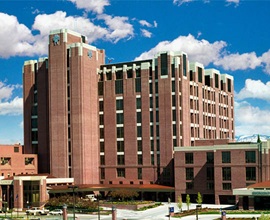St. Luke’s Downtown Campus Expansion Begins with Tree Move and Road Construction
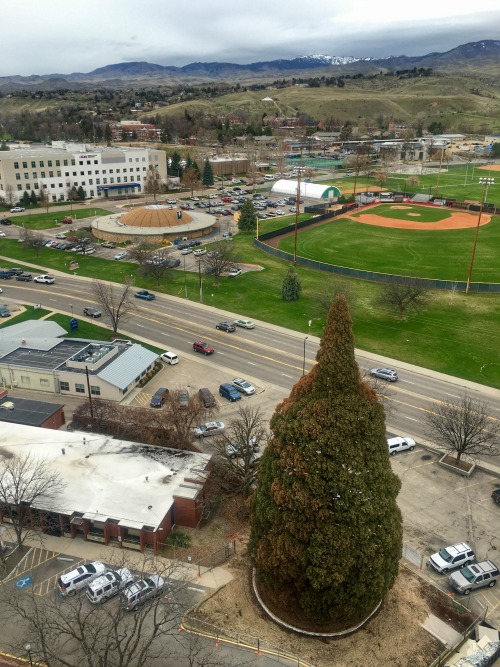
As St. Luke’s prepares to expand its downtown Boise hospital, a beloved part of the downtown campus will move to a new home. St. Luke’s is donating a 100-year-old sequoia tree to the City of Boise to allow future generations to enjoy the special tree.
St. Luke’s will begin the elaborate process this week to preserve and relocate the giant sequoia. The epic two-week event is expected to draw crowds who want to witness the historic tree make the trip to its new home at Fort Boise Park.
To do so will take impressive work. St. Luke’s hired the country’s top large tree mover, Environmental Design Inc., to manage the move. On June 13, crews from Environmental Design Inc. returned to St. Luke’s to prepare the 98-foot tree for its trip across Fort Street. The entire process will take close to three weeks, with the move itself stretching over four to five days.
In October, the tree mover prepared the sequoia by pruning its roots and installing a barrier to temporarily prevent further growth. During the first week of work, that support will be replaced and enhanced. Workers will build a wire, burlap and wood structure around the base of the tree along with a steel lattice support system that will be inserted under the tree. The following week, the crew will excavate under the steel structure and insert giant 40-foot long balloons that will eventually be inflated to lift the tree three to six feet, so crews can tow it out of the hole.
From there, the tree will inch its way to the edge of Fort Street, then across the street and over to its new pit at Fort Boise Park. The tree will be moved 10 to 12 feet at a time over the course of about a minute and-a-half. At that rate, the tree movers say it will take eight hours for the tree to move 250 to 300 feet. When the sequoia finally reaches its new location, the tree will be lowered in, the giant balloons deflated and removed, along with the steel pipes and root barrier. The area around the sequoia will be backfilled with soil from the original location.
St. Luke’s worked with the Boise City forester to determine which location in Fort Boise Park was best-suited to ensure the health of the tree. It was determined the spot most similar to where it has lived for more than 100 years is near the intersection of 1st, Fort and State streets. Environmental Design will routinely check in and monitor the sequoia’s health over the next five years.
St. Luke’s will post updates from and about the sequoia. Please follow along and use the hashtag on Twitter and Instagram, #BoiseSequoia.
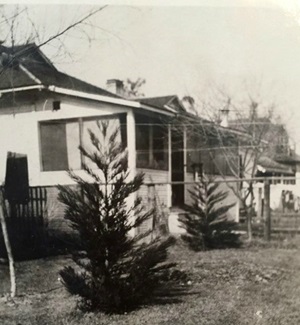
History of the Sequoia
As the tree's designated community steward, St. Luke's is committed to protecting and maintaining this treasure. The giant grew from a tiny cutting of a Sequoia presented as a gift to Doctors Fred and Alice Pittenger and planted next to their home around 1912.
The Sequoia was a gift from the conservationist Emile Grandjean, one of Idaho's first foresters. Mary Grandjean, the granddaughter of Emile, says originally there were two Sequoia trees near St. Luke’s. According to her family’s oral accounts, the seedlings came from John Muir in California and arrived in Idaho by express. Emile received four, with two given to the Pittenger Family. The other two were planted in the backyard of the Grandjeans' home on 11th St. in Boise. The photo to the left shows the size of those Sequoias a few years after they were planted.
In the 1980's the tree almost died. The culprit - the spirit of Christmas. St. Luke's started decorating the tree in 1984, and it became known as "Boise's Christmas Tree." For two weeks every year, people flocked to see thousands of lights strung around the limbs, decorations displayed below, and to sing Christmas carols.
Despite consulting with a local horticulture company to ensure the decorations would not harm the tree, the Sequoia began to decline. St. Luke's removed the asphalt around it, and several nearby junipers, but the tree's needles continued to brown. So, after the 1987 holiday season, St. Luke's canceled future celebrations in order to save the tree.
As the tree continued to deteriorate, St. Luke's brought in experts from California. At their recommendation, the top dead 11 feet were cut off, and all surrounding turf removed. A "leader" branch was bent up in hopes it would grow to replace the treetop.
Almost 30 years later, the giant Sequoia is hearty once again, and healthy enough for its monumental move.
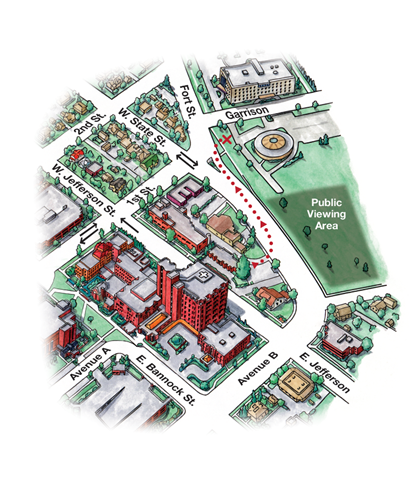
Watch the Sequoia Move
In order to accommodate for the safety of all spectators, St. Luke’s is urging people who would like to watch to head to Fort Boise Park. The grass area along the back of the ball field is directly across Fort Street from the tree and the action. Parking is limited. Riding bikes or walking is encouraged. It’s also important to note the area around St. Luke’s is a no-fly zone. Personal drones will not be allowed during the tree’s move, and pose a serious risk to Air St. Luke’s and other medical transport helicopters.
When it’s time for the tree to move across Fort Street, the road will be temporarily closed. That’s anticipated to occur sometime between late Friday, June 23 and Sunday, June 25, depending on the progress of the work and ACHD approvals. Drivers in the area and people attending events at Fort Boise Park should allow for extra time and a detour. St. Luke’s will utilize all communication channels as far in advance as possible in order to alert the community to details of that closure.
Initial Phase of Road Construction Set to Begin
After several years of planning, St. Luke’s Health System, in conjunction with ACHD and the City of Boise, will begin road construction around its downtown Boise campus. The work is in preparation for a development project that will expand the downtown hospital to enhance access and care for the growing community, and provide improved transportation in Boise’s urban core.
The first phase of work centers on $5 million worth of improvement to public roads and infrastructure in a 12-block area around the hospital to enhance the overall connectivity of the surrounding area. Construction crews will be concentrated at the intersection of 1st, Fort and State Streets, along Idaho Street, and at Avenue B and Jefferson Street. Drivers and cyclists are encouraged to allow a few extra minutes for their commutes through the area, or find alternative routes to avoid delays. (More information on detours to be provided soon.)
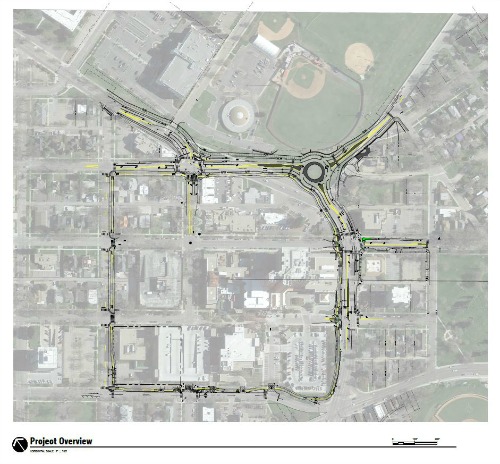
Starting likely the week of June 19, Central Paving will start installing temporary traffic signals in anticipation of an initial traffic shift. Those new signals will be placed at the intersections of 1st, State and Fort Streets, as well as on Avenue B and Jefferson Street. Temporary paving will then take place on the northwest corner of Jefferson and Avenue B, as well as the SE corner of 1st Street and Fort Street. This work will require crews to temporarily close traffic lanes as needed, and will impact bicycle lanes. A temporary sidewalk will be installed to ensure pedestrians maintain access, and pedestrians and cyclists will be moved to the other side of the street when sidewalks are closed. Drivers should reduce speeds in anticipation of road bumps and construction workers along the sides.
Approximately two weeks later when that work is complete, traffic will be shifted to one lane in each direction on Avenue B, Fort and State Streets so construction crews can complete all utilities and roadwork. Then after the Suez Water main project on Jefferson is complete and that road is reopened, Reserve Street will be closed (pending ACHD approval) and detoured traffic moved to Jefferson. That is anticipated to occur in early to mid-July, and St. Luke’s will work to provide advance notice and detour information to hospital visitors, neighbors, staff and people who drive through the area.
Simultaneously, work along the perimeter of the campus will also commence. This will include building the cycle track and new sidewalks along Idaho Street. This construction will require local sidewalks to be closed and detours coordinated in advance to minimize pedestrian impacts. To construct the new sidewalk, curbs and gutters, and the cycle track, parking will not be allowed on 2nd Street, but two lanes of travel will remain open. On Idaho, traffic will be moved to one lane and shifted south. As soon as ACHD approves detour plans, St. Luke’s will be sure to share those with the community through our media partners, on our social media sites, and on this blog. You can always find a link to the most recent post on the St. Luke’s Boise Development webpage.
Due to the sidewalk and cycle track improvements, trees in this area will be removed. Some of these trees were determined to be unhealthy, and were already slated for removal. St. Luke’s will work closely with the Boise City Forester to adequately replace the trees, and will plant them in the cycle track median at the appropriate date. The city appraised each tree and assigned a value. St. Luke’s intends to plant trees that are more valuable than required under city code. When the project is complete the replacement trees will provide a beautiful canopy around the perimeter of the hospital.
Work in this area will last at least through early next year, depending on the weather. The next phase will follow and concentrate on the new roundabout planned at Fort, Robbins and 3rd Streets.
This is not a “single project,” but a multi-phased plan that will occur in stages over the years to come. At its core is our commitment to create an environment in which we can provide the best possible care for patients and families, in an environment geared toward safety, healing and comfort.
Projects:
- New Children’s Pavilion (under construction)
- New central plant
- New parking structure
- New hospital tower
- Expand and modernize St. Luke’s MSTI cancer center
- Expand and modernize St. Luke’s Children’s Hospital
- Expand and upgrade the current hospital tower
When complete, the entire project will be one of the largest investments ever made in Boise and Idaho. It will bring new jobs to the region, while building on Boise’s growing reputation as one of the most livable cities in the country, of which access to high-quality health care is a critical component. The project will be financed through bonds, cash on hand and community philanthropy. This major development project is estimated to bring up to $1.2 billion of rollover economic benefit and job growth to the community.
About The Author

Anita Kisseé was the Treasure Valley public relations manager for St. Luke’s Health System.

